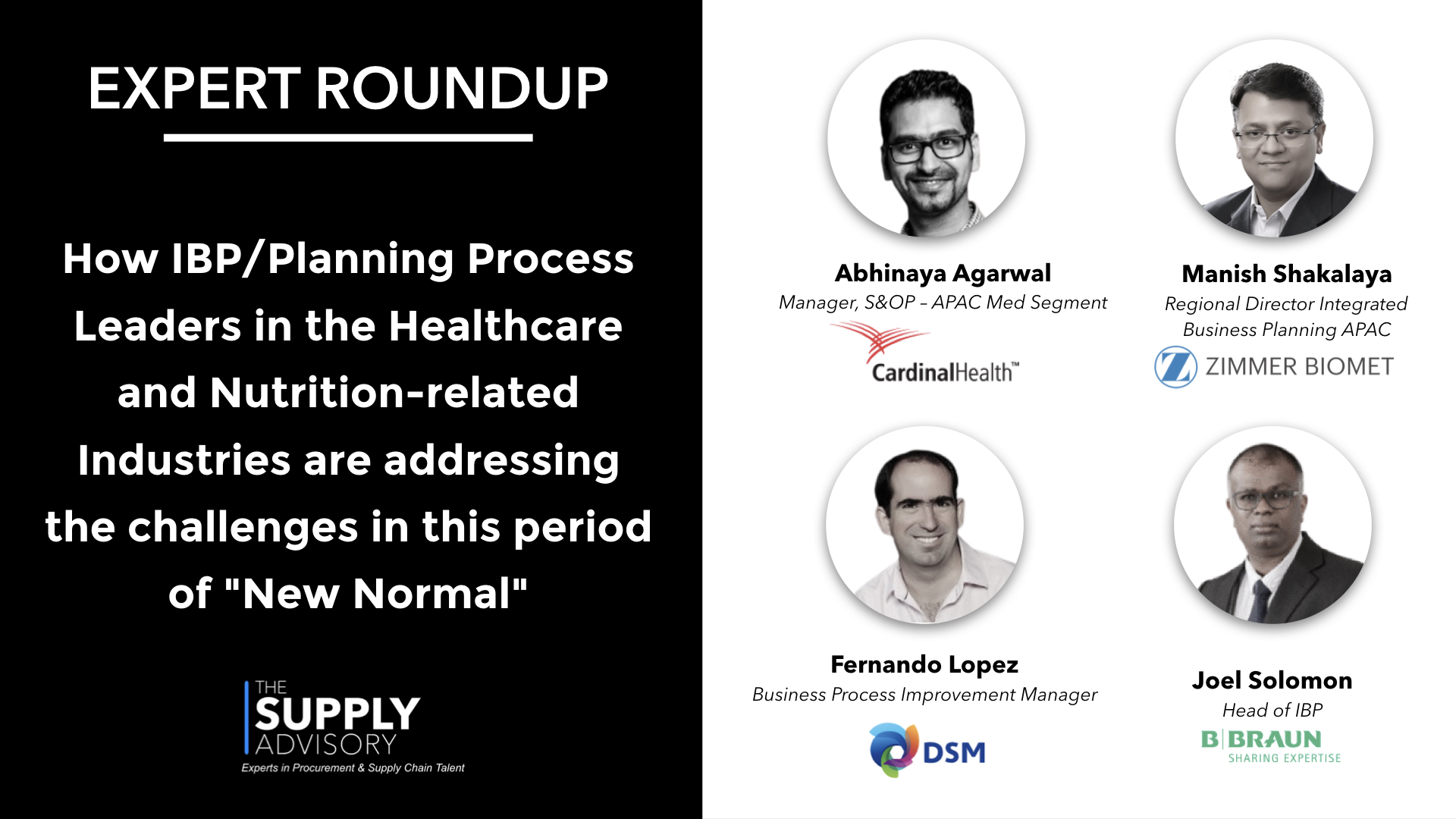
About seven years back or so, a new kid on the block started doing the rounds and gaining traction in the market as being the “ideal practice” for planning. Supply Chain leaders were speaking about moving away/graduating from “Sales and Operations Planning” and getting into what is called “Integrated Business Planning”.
To make that shift, many critical points were discussed. Should the IBP function report to Supply Chain or be owned by Commercial or be a stand-alone function? Should the methodology/process alone be implemented, or should the tools/systems/related ERP modules be implemented in parallel/serial? Organisations went through a journey to arrive at these answers and more to structure their implementation/sustainability road map.
However, 2020 hit organizations with a new set of challenges and the IBP function was not spared either, be it in implementing it afresh or running it as such.
In this Expert Roundup, we invited four Regional IBP/Planning Leaders from Healthcare and Nutrition-related industries to help us explore and understand how they are managing the challenges around implementations/carrying out IBP in this period of “New Normal”.
Our contributors for this expert roundup include:
- Abhinaya Agarwal, Cardinal Health
- Fernando Lopez, DSM
- Manish Shakalya, Zimmer Biomet
- Joel Solomon, B. Braun Group
Check out the top 3 challenges and the tips to overcome these challenges that will help you effectively strategize and execute Integrated Business Planning across the region.
Abhinaya Agarwal
Manager, S&OP – APAC Med Segment
Cardinal Health
Challenge 1: Engagement – Participation and attention from cross-functional stakeholders for IBP Workshop / Engagement sessions
Tips: Request participants to turn-on their video camera throughout the workshop/engagement sessions. Have more fun-focused and group activities to drive interest. Split the session into half-days rather than full-day workshops to avoid participants getting tired. Keep the content crisp and relevant to gather attention
Challenge 2: Virtual relationship – Building virtual relationships to drive IBP implementation
Tips: Leverage on the In-Country Supply Chain / Commercial Head to drive frontline engagements on IBP including importance and change management. Have one-on-one virtual sessions with key stakeholders to build rapport. Use more localized marked based examples to drive understanding and importance of concepts. Keep the stakeholders engaged by regular newsletter on the progress of IBP implementation
Challenge 3: Technology/Content – Platform challenges and content sharing among participants
Tips: Ensure participants are trained on using virtual platforms and like Zoom, Microsoft Teams, etc. and its features for workshops. Create a backup plan in case there are last-minute issues with virtual platforms during sessions/workshops. Create a central TeamSpace for stakeholders to access all relevant material beforehand
Manish Shakalaya
Regional Director Integrated Business Planning APAC
Zimmer Biomet
Challenge 1: Management teams focusing disproportionately on ensuring survival in the Short term driven by the Cash conservation approach while not allocating enough resources (capital or people) on reimagining the world post-COVID-19 to enable Long Term survival
Tips: It is recommended that we use our “2 eyes” the way they were never programmed to be used – Focus with one eye on supply responsiveness to address demand volatility while remaining focused with the other eye on the projection of the future demand curve which will rapidly evolve basis multiple macro variables (socio-economic and socio-political)
Challenge 2: Management teams are finding it tough to practice “Truth as we know it in all our Plans” – the most fundamental behaviour expected for a mature Integrated Business Planning
Tips: In the current COVID world, mistakes are bound to happen due to ambiguity, lack of timely information, and the inability to synthesize available facts to make informed decisions.
One of the most effective ways to resist falling into the trap is to ask the teams for imagining the “new normal” post-COVID by developing multiple scenarios and then taking decisions on those scenarios.
Challenge 3: Management teams are extremely keen to micromanage, given the volatility of the situation, thereby increasing the frequency of IBP meetings from monthly to weekly.
Tips: Avoiding micromanagement is not a choice as it is a matter of survival. An effective way, given more management time availability, is to have a clear agenda carved out for such connections with the Leadership thereby enabling focused discussions leading to effective and timely decision making.
Fernando Lopez
Business Process Improvement Manager
DSM
Challenge 1: Supply or Demand shock
Tips: Ensure you understand it. Covid-19 brought together two types of shock: Demand and Supply. From the supply perspective, as lockdowns were announced, manufacturing companies rushed to secure the stocks to maintain their Supply Chains de-risked. Concurrently, true demand shocks also appeared (from toilet paper bicycles). Levering your IBP process to dig deeper into these market dynamics will help you to differentiate between the short, mid, and long term impact. By understanding what’s behind the increase in sales forecast companies can get the most out of the pandemic and take the right decisions.
Challenge 2: Time to invest
Tips: Covid-19 was an excellent time to spend on those long-postponed projects. This is because companies reduced spending in areas such as travel. If you were in an industry resilient for the economic upset, probably you had some spare budget. Covid-19 was the perfect time to accelerate those investments (from system upgrades to consulting) that otherwise would be treated as a second priority. And those investments will pay-off in the long term.
Challenge 3: Compensating for the loss of face to face visits
Tips: One element to enrich the sales forecast is the intelligence that sales teams get via their alternative sources. With Covid-19, visits to customers’ production facilities (an excellent source of information) are rather limited. This can result in account managers losing the “sensibility” of the account. One piece of advice to overcome this is to provide training in alternative techniques such as online selling. Investing early in these kinds of skills will keep your sales force motivated and engaged with their customers, which in turn result in better market intelligence.
Joel Solomon
Head of IBP
B. Braun Group
Challenge 1: New dynamic changes
Tips: Market insights, dynamics, and assumptions as we know it may not apply for this year and next year. Everything is either “hazy”, “very short term” or changing faster than we can adapt. A good IBP process at the current situation would see it as a threat or opportunity. This type of dynamic changes and moving target helps us to learn how to adapt through IBP to create an environment or a paradigm shift to create agility and responsiveness.
Challenge 2: Overcoming the challenges of the new norm
Tips: We also need to change the way we work with a different approach. More and more teams are working away from a physical office and moving to the realm of virtual meetings. This year in our organization we have carried out most of our IBP meetings virtually. One of the challenges to overcome to have successful, insightful and decision-driven IBP programs is to focus more and more on data analytics that drives key insights for quicker decision making.
Challenge 3: The role of leadership and the right attitude
Tips: We can have the most exciting software, most robust process but all this will not deliver success without the right leadership, emotions, and attitude in our current circumstances. Within the challenges we have, we need to ensure the human connectivity is not lost, we need to create more informal virtual meets within our organization to continuously fuel if you may the thought processes, the energy, the will to succeed even compliance to ensure our business process may help to deliver a winning organization.
More changes and adjustments in the way of doing things can be expected in this area in response to the pandemic. As you’ve seen in the roundup above, our guest Supply Chain leaders are planning and implementing changes to prepare for the coming years. Again, we at The Supply Advisory would like to thank our contributors, Abhinaya, Fernando, Manish, and Joel for carving out time to share their insights on this key subject. We appreciate your generosity!
Stay tuned here at The Supply Advisory Blog for more expert roundups and other exciting content on Supply Chain Management.

Ananya Sinha Roy is the Director at The Supply Advisory (a division of Datasearch Consulting), a leading executive recruitment firm specialising in Procurement & Supply Chain.
You can view the The Supply Advisory website or contact them directly at info@supplyadvisory.com for a more detailed discussion.



